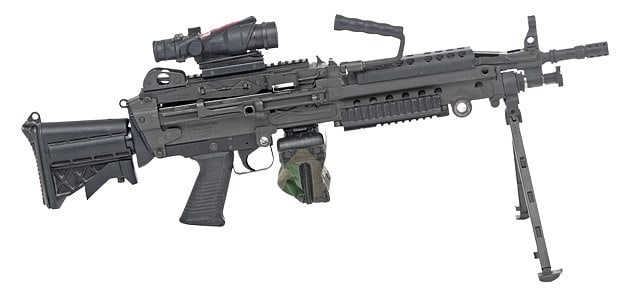
Introduction to the M249
The M249 Squad Automatic Weapon (SAW), officially designated as the M249 Light Machine Gun (LMG), has been a cornerstone of U.S. infantry firepower for decades. Originally derived from the FN Minimi, a Belgian-designed light machine gun, the M249 was adopted by the U.S. military in the early 1980s to enhance squad-level automatic fire capabilities.
Despite ongoing debates over its continued role in modern combat, the M249 remains a mainstay of U.S. Army and Marine Corps infantry squads, providing sustained suppressive fire with belt-fed 5.56×45mm NATO ammunition.
This article provides a detailed analysis of the gun, including its history, technical specifications, ammunition compatibility, operational performance, and comparisons to other military firearms.
Development and Adoption of the M249
The origins of the M249 trace back to the Vietnam War era, when the U.S. military recognized a significant gap in infantry firepower. At the time, the standard infantry rifle, the M16, lacked the sustained fire capability necessary for effective squad-level suppression. The only fully automatic alternative was the M60 general-purpose machine gun (GPMG), which was heavy (23 lbs unloaded) and chambered for 7.62×51mm NATO, making it unwieldy for individual squad members.
The Need for a Squad Automatic Weapon
In response, the U.S. Army and Marine Corps sought a light, portable, and belt-fed automatic weapon that could provide sustained fire support while maintaining compatibility with the 5.56mm cartridge, ensuring logistical simplicity alongside the M16 rifle.
Trials were conducted in the 1970s under the Squad Automatic Weapon (SAW) program, evaluating multiple prototypes, including:
- FN Minimi (Belgium) – The eventual winner.
- HK 23 (Germany) – Rejected due to complexity and weight.
- Maremont XM106 (USA) – Derived from the Stoner 63 but deemed unreliable.
- Rodman XM248 (USA) – An experimental design that was ultimately discarded.
After extensive testing, the FN Minimi was selected in 1982 and officially designated the M249.
Production and Early Issues
Initially manufactured in Belgium, full-scale domestic production began in the late 1980s at FN Manufacturing, LLC (now FN America) in South Carolina. Early production models suffered from jamming and overheating issues, leading to the Product Improvement Program (PIP) in the 1990s.
Key PIP modifications included:
- Hydraulic buffer system to reduce recoil.
- Heavier barrel for improved sustained fire.
- Heat shield to prevent barrel overheating.
- Enhanced feed system to improve reliability.
These improvements significantly boosted durability and reliability, cementing the M249’s role as the primary squad automatic weapon of the U.S. military.
Technical Specifications and Performance
The M249 is a gas-operated, air-cooled, belt-fed machine gun with an open-bolt firing system. This design minimizes overheating and ensures consistent rate of fire, crucial for sustained combat engagements.
Key Specifications:
- Caliber: 5.56×45mm NATO
- Action: Gas-operated, open bolt
- Feed System: M27 linked belt or STANAG magazine (30 rounds)
- Weight: 17 lbs (unloaded)
- Rate of Fire: 750–1,000 rounds per minute
- Effective Range: 800 meters (point target), 1,000 meters (area target)
- Maximum Range: 3,600 meters
Ammunition and Feeding Mechanism
The M249’s ability to fire both linked ammunition belts and M16 magazines is one of its defining features. However, practical field experience has demonstrated that feeding from magazines is unreliable, as the spring tension in rifle magazines struggles to keep up with the weapon’s high rate of fire.
The primary ammunition types used with the M249 include:
- M855 (Standard Ball) – Green tip 5.56mm round, used extensively.
- M856 (Tracer) – Provides visible trajectory for marking targets.
- M855A1 (Enhanced Performance Round) – Superior penetration and lethality.
Comparison with Other Military Machine Guns
M249 vs. M240 (7.62mm GPMG)
- The M240, chambered in 7.62×51mm NATO, serves as a general-purpose machine gun rather than a squad weapon.
- Pros of M240: Greater range, stopping power, and effectiveness against fortified targets.
- Pros of M249: Lighter weight, higher portability, and ammunition commonality with standard infantry rifles.
M249 vs. M27 IAR
In recent years, the U.S. Marine Corps has shifted toward the M27 Infantry Automatic Rifle (IAR) as a partial replacement for the M249 in some units.
- M27 (based on the HK416 platform) is magazine-fed, limiting sustained fire capability.
- M249 is belt-fed, offering superior firepower for extended suppressive engagements.
- While the M27 is lighter and more mobile, it lacks the M249’s ability to lay down continuous fire for long durations.
M249 vs. International Counterparts
- Negev NG7 (Israel) – Uses 5.56mm and 7.62mm configurations, with a slightly improved weight-to-performance ratio.
- Daewoo K3 (South Korea) – Heavily based on the FN Minimi but with local enhancements.
- PKP Pecheneg (Russia) – Chambered in 7.62×54mmR, it outperforms the M249 in firepower but is significantly heavier.
Tactical Employment and Modern Role
The gun is an integral part of modern infantry tactics, designed to provide sustained suppressive fire at the squad level.
Primary Roles:
- Suppression of enemy positions – Enables maneuverability for advancing units.
- Defensive firepower – Controls battlefield areas by limiting enemy movement.
- Patrol and convoy support – Mounted on vehicles or carried for increased protection.
Limitations and Challenges
Despite its strengths, the M249 has faced criticisms:
- Weight: While lighter than GPMGs, 17 lbs (unloaded) is still heavy compared to an M4.
- Overheating: Requires frequent barrel changes in sustained engagements.
- Magazine feeding issues: Not reliable under sustained fire conditions.
Conclusion
The M249 Squad Automatic Weapon remains a critical component of U.S. infantry firepower, offering unparalleled suppressive capabilities at the squad level. While newer alternatives like the M27 Infantry Automatic Rifle have emerged, the belt-fed firepower and versatility of the gun to ensure its continued relevance in modern warfare.
Despite challenges such as weight and maintenance, its combat effectiveness and battlefield presence make it an indispensable asset. Whether in urban combat, desert warfare, or jungle operations, the gun has proven itself time and again as a reliable and effective weapon system.
As military doctrine evolves, so too will the role of light machine guns like the M249, but for now, it remains a battle-tested and combat-proven tool of modern warfare.
Read more about the M249 here:
If you know of any forums or sites that should be referenced on this listing, please let us know here.








